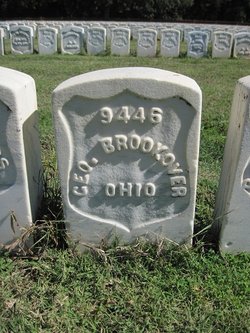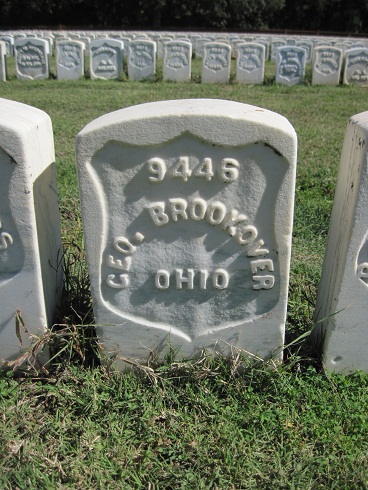Two months into his term of service when on July 3, 1864, at the Battle of North Mountain in West Virginia he was captured by the Confederates and taken to the infamous Andersonville Prison at Andersonville, Georgia.
Fellow soldiers, George M. Crooks and Frank Davy, from Muskingum County, Ohio, in the same company as George Brookover and actually shared a tent with him in this hell hole of a prison, stated in a deposition that they gave in June 1865 that George Brookover came down with a very severe case of dysentery at the end of August 1864 and it was this affliction coupled with the starvation they were forced to endure in early September that threw him into a fever that partially deprived him of his senses in the last days before his passing, George Brookover breathing his last, according to them, in Andersonville Prison on September 19, 1864.
The Confederate Civil War Prison known as Andersonville was established in November of 1863 and the first prisoners began arriving three months later in February of 1864. From this date until the war ended in April of 1865, 49,485 Union soldiers were imprisoned at this infamous Georgia prisoner of war camp, with as many as 30,000 of them being crammed at one time into this 27 acres of open swamp land that was enclosed by pine log walls fifteen to twenty feet high.
Notorious for its utter lack of shelter and sanitation, its overcrowding, and its brutal guards, it was no doubt by far the worst of the Confederate prisons. Exposed continuously to the elements, receiving insufficient and inadequately cooked food, drinking impure water from the narrow and shallow polluted stream that bisected its boundaries, wallowing in the filth that resulted from packing too many men into such a small place, its inmates were easy victims of diseases like scurvy and dysentery (both of which afflicted George Brookover), diseases that in the short fourteen months of its existence led to the deaths of more than 13,700 Union soldiers, a devastating mortality rate of over 25%, meaning that one out of every four men imprisoned there did not survive the terrible ordeal. Those who perished were subsequently buried unceremoniously in a near-by prison burial ground. Fortunately, all but about a thousand of these graves were later identified and marked after the war and this spot today is recognized as a national cemetery.
How bad exactly were conditions at Andersonville while George W. Brookover was a prisoner there? Well, they were so bad that even the Southerners themselves finally decided the situation had become intolerable, two Confederate medical doctors recommending in the fall of 1864 that the prisoners be moved elsewhere. As a result, the Confederate Army started moving their captives to other prisons, but by this time it was already too late for George Brookover. But at least someone did eventually end up paying for the unwarranted death of this thirty-three year old Ohio infantryman as well as nearly fourteen thousand other soldiers just like him who perished in this appalling hell hole. So inhumanely run was this ghastly prisoner of war camp that its Swiss-born superintendent, Major Henry Wirz (1822-1865), was tried and convicted of murder shortly after the war and subsequently hanged on November 10, 1865, the only person, it is worth stressing, who was ever executed by the North for war crimes after the Civil War ended.
Two months into his term of service when on July 3, 1864, at the Battle of North Mountain in West Virginia he was captured by the Confederates and taken to the infamous Andersonville Prison at Andersonville, Georgia.
Fellow soldiers, George M. Crooks and Frank Davy, from Muskingum County, Ohio, in the same company as George Brookover and actually shared a tent with him in this hell hole of a prison, stated in a deposition that they gave in June 1865 that George Brookover came down with a very severe case of dysentery at the end of August 1864 and it was this affliction coupled with the starvation they were forced to endure in early September that threw him into a fever that partially deprived him of his senses in the last days before his passing, George Brookover breathing his last, according to them, in Andersonville Prison on September 19, 1864.
The Confederate Civil War Prison known as Andersonville was established in November of 1863 and the first prisoners began arriving three months later in February of 1864. From this date until the war ended in April of 1865, 49,485 Union soldiers were imprisoned at this infamous Georgia prisoner of war camp, with as many as 30,000 of them being crammed at one time into this 27 acres of open swamp land that was enclosed by pine log walls fifteen to twenty feet high.
Notorious for its utter lack of shelter and sanitation, its overcrowding, and its brutal guards, it was no doubt by far the worst of the Confederate prisons. Exposed continuously to the elements, receiving insufficient and inadequately cooked food, drinking impure water from the narrow and shallow polluted stream that bisected its boundaries, wallowing in the filth that resulted from packing too many men into such a small place, its inmates were easy victims of diseases like scurvy and dysentery (both of which afflicted George Brookover), diseases that in the short fourteen months of its existence led to the deaths of more than 13,700 Union soldiers, a devastating mortality rate of over 25%, meaning that one out of every four men imprisoned there did not survive the terrible ordeal. Those who perished were subsequently buried unceremoniously in a near-by prison burial ground. Fortunately, all but about a thousand of these graves were later identified and marked after the war and this spot today is recognized as a national cemetery.
How bad exactly were conditions at Andersonville while George W. Brookover was a prisoner there? Well, they were so bad that even the Southerners themselves finally decided the situation had become intolerable, two Confederate medical doctors recommending in the fall of 1864 that the prisoners be moved elsewhere. As a result, the Confederate Army started moving their captives to other prisons, but by this time it was already too late for George Brookover. But at least someone did eventually end up paying for the unwarranted death of this thirty-three year old Ohio infantryman as well as nearly fourteen thousand other soldiers just like him who perished in this appalling hell hole. So inhumanely run was this ghastly prisoner of war camp that its Swiss-born superintendent, Major Henry Wirz (1822-1865), was tried and convicted of murder shortly after the war and subsequently hanged on November 10, 1865, the only person, it is worth stressing, who was ever executed by the North for war crimes after the Civil War ended.
Gravesite Details
PVT B 135 OHIO INF
Family Members
Advertisement
Advertisement

















